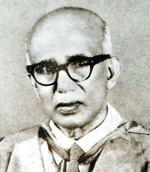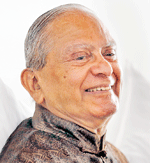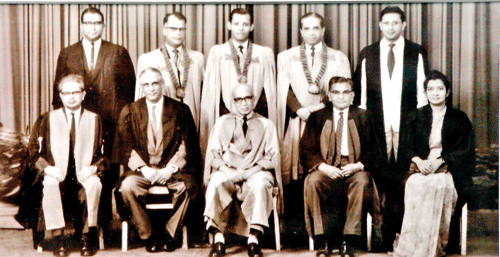Ceylon College of Physicians: The realisation of a dream 50 years ago

Founder President Dr. E.M. Wijerama
A quick chat, most probably over cups of tea, a half-century ago before they hurried back to their wards at the General Hospital in Colombo, to engage in their revered vocation of healing…………in the wake of which follows the birth of the ‘oldest’ professional body of doctors, the Ceylon College of Physicians (CCP).
The beginnings were simple, starting with a handful of 10 distinguished Physicians, who met in the Consultants’ Lounge of the General Hospital, now the National Hospital of Sri Lanka, on that momentous day of July 25, 1967. The inaugural meeting of the CCP soon followed on September 26 at the hospital’s Clinical Lecture Theatre, after which the eminent 10-member First Council, all in their ceremonial robes, posed for a historic black-and-white photograph.
Among them only one was from the fairer-sex, saree-clad Dr. (Mrs.) Doris Peiris, while the others included Founder President Dr. E.M. Wijerama, Dr. E.H. Mirando, Prof. K. Rajasuriya, Prof. N.D.W. Lionel, Dr. O.R. Medonza, Dr. D.B. Gunasekara, Dr. W.D.L. Fernando, Dr. C.P. Wijesinghe and Dr. L. Ranasinghe.
The council did not waste much time but got to work promptly, holding its first meeting on October 10, 1967 at the Ceylon Medical Association House (now the Sri Lanka Medical Association – SLMA), 6, McCarthy Road, Colombo 7, which had by that time coincidentally been donated by Dr. Wijerama, and decided on the eligibility criteria for membership.

Dr. Lakshman Ranasinghe: A walk into the past
Three categories they set forth: Any member of a recognized college of physicians without regard to the subjects they have specialized in; medical practitioners with post-graduate doctorates in General Medicine; and practitioners holding post-graduate degrees in allied subjects – by applying to the Council.
All except two of this core group are no more as the CCP which has grown in leaps and bounds to more than 800, gently flexes its muscles for the betterment of the people. For the first time, the CCP under its current President Dr. S.D. Jayaratne held a monumental International Healthcare Exhibition and Medical Symposium last weekend, as part of its 50th anniversary celebrations.
In contrast to the nearly 50,000 people who attended this exhibition at the BMICH and hundreds who organized it under the guidance of the CCP, the first Foundation Lecture of the CCP had been delivered on February 19, 1968 (Pre-Poya Day) at 6 p.m. to a crowd of 119 members and guests at the Anatomy Lecture Theatre of the Colombo Medical Faculty. The speaker was Dr. Wijerama himself on ‘Physicians, ancient and modern’ and the Chief Guest none other than the then Chief Justice Hugh Fernando.
Thereafter, they had adjourned to Hotel Samudra most probably for drinks and a gala dinner at an “unbelievable” Rs. 15 per plate!
It is on a sunny morning a few weeks ago that we meet one of the CCP Founders, well-known Consultant Dermatologist, Dr. Lakshman Ranasinghe, as the other, Prof. Channa Wijesinghe, a Consultant Psychiatrist is living across the seas in Melbourne, Australia. Having attended numerous dinners of the CCP down the years, Dr. Ranasinghe does not remember what sumptuous food they tucked into on that night of February 19, so long ago. But the other memories are yet vivid.
While working as a young Paediatric Dermatologist at the Lady Ridgeway Hospital for Children in Colombo that Dr. Ranasinghe was approached by the most-senior Paediatrician, Dr. E.H. Mirando, who told him of his “dream” – that although Paediatricians had an association, there was no such group for Physicians.
“I have a dream to start a college, an Academic Postgraduate Medical College for Physicians, Paediatricians and Psychiatrists,” Dr. Mirando told the energetic doer, Dr. Ranasinghe.

The very 1st Council of the Ceylon College of Physicians: Standing (from left) -- Dr. N.D.W. Lionel, Dr. O.R. Medonza, Dr. C.P. Wijesinghe, Prof. K. Rajasuriya and Dr. L. Ranasinghe and seated (from left) -- Dr. E.H. Mirando, Dr. D.B. Gunasekara, Dr. E.M. Wijerama, Dr. W.D.L. Fernando and Dr. (Mrs.) Doris Peiris
Later, they “button-holed” the most Senior Physician at the Colombo General Hospital, Dr. Wijerama — whose memory is kept alive in the minds of doctors whenever they drive along Wijerama Mawatha (earlier McCarthy Road) in Colombo 7 or enter his beautiful ‘Wijerama House’– and worked out the details for the formation of the CCP.
While Dr. Wijerama was elected the first President, Dr. Wijesinghe was elected the Secretary, at the inaugural meeting, recalls the then ‘junior-most’ Consultant, Dr. Ranasinghe, adding that he had been given the task of seeing to the nitty-gritty in anticipation of the preliminary meeting.
Earlier, deliberations had hinged on the draft Constitution that would govern the CCP, the task of which was entrusted to Dr. Ranasinghe, who smilingly adds how it was based on the Constitution of the Science Association of St. Joseph’s College, Colombo, of which he had been the President as a schoolboy.
Adopting the draft Constitution at the inaugural meeting, all those present on that day and those applying for membership within a month, had become qualified to be ‘Founder Members’ of the fledgling CCP which would be based in a room at the SLMA. The first Clerk was Walter Perera who “very efficiently” coordinated its activities, says Dr. Ranasinghe.
“Dr. Wijerama was a fountain of knowledge and reservoir of inspiration, who gave exemplary leadership, while allowing all voices to be heard, reserving his observations to the last,” Dr. Ranasinghe reminisces.
Looking back at those early times, he says that an “outstanding” achievement of the CCP was getting the franchise from the Royal College of Physicians (RCP) based in England to conduct the Part I Examination in Colombo when seeking the Membership of the RCP.
“The examination papers were sent to the CCP and of the 50 who sat them, 49 got through which the RCP called quite an achievement,” he says, pointing out that at the time the CCP was born there was no post-graduate medical college in the country, only a few associations of doctors including the SLMA established in 1887 and a paediatricians’ association.
The objectives of the CCP were simple — to organize scientific meetings restricted to the presentation of original research papers by members and lectures by visiting professors.
And so the CCP set out on the path of initiating discussions through workshops and seminars on topics important to their profession, steering the healers, while also setting off fun-times through social gatherings which did not leave out their spouses.
Having pored over yellowed and dog-eared documents, Consultant Physician and Clinical Pharmacologist Prof. Chandanie Wanigatunge, on whose able shoulders has fallen the compilation of the 50-year history of the CCP into a souvenir, says that the 1st Scientific Meeting Lecture of this august body was held on June 18, 1968.
The heart as well as accidents seems to have been the focus of the Physicians even then, with the Ratnapura General Hospital’s Physician, Dr. K. Dharmadasa talking on ‘The electrocardiogram in healthy young Ceylonese’.
In subsequent years the spotlight had fallen on ‘The role of the physician in road safety’ by Dr. I.S.M. Fernando and ‘Topics in cardiovascular pharmacology’ by Dr. D.R. Laurence.
There also seems to have been no intention on the part of the founders to cling on to power, with documented proof that the First Annual General Meeting of the CCP was held on September 29, 1968.
The official CCP emblem had been designed in December 1968. It would be the mythical medicinal pot with the traditional oil lamp, representing the spread of knowledge and the healer’s snake-and-staff, the international symbols of the profession within it. With the name of the college appearing above the pot its motto in Sanskrit ‘Arogyam Shanthi Sukham’ occupied the space below in large letters, with the English translation ‘Cure, Relief & Comfort’ within the pot. The pot is encircled by petals of the nelum flower.
The CCP colours, maroon, black and silver, displayed on its banner had been designed by Dr. Ranasinghe but as the CCP steps into its 50th year, he has a gentle request – to alter the emblem so that the English translation is outside the pot in bigger type and the Sanskrit version inside in smaller lettering.
The Journal of the CCP, titled ‘Transactions’ first appeared in print in September 1969.
Prof. Wanigatunge says that by December 1969, the 1st Honorary Fellow, Sir Max Rosenheim was inducted to the CCP and in 1971 the Cyril Fernando Memorial Lecture was inaugurated followed by the Dr. P.B. Fernando Memorial Oration.
The CCP was incorporated by a statute in its very first year, the Bill being presented to the Senate by Senator Dr. R.B. Lenora and ratified by the Senate in 1971 , she says, adding that it became the first college in the country to be so incorporated.
Now, the CCP has left the haven that has been ‘Wijerama House’ to have its own modern home down Kotte Road, Rajagiriya which these days is a hive of activity.
Over the years there has been diversification of the original objectives of this non-profit oriented academic body.
Putting out a bi-annual journal and a newsletter for the membership, the CCP is an international centre for the MRCP (UK) Parts 1 and 2, while playing an advisory and lobbying role to the Health Ministry.


